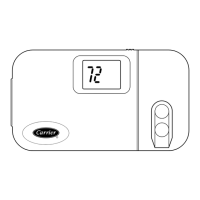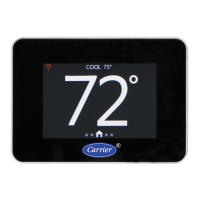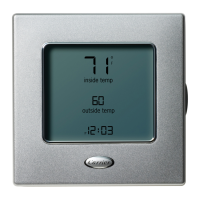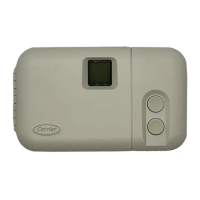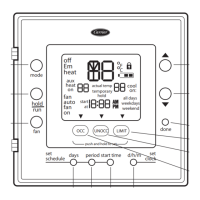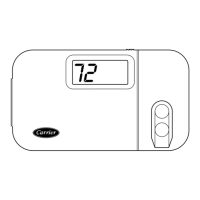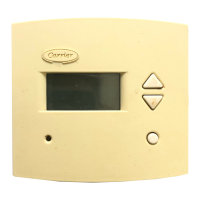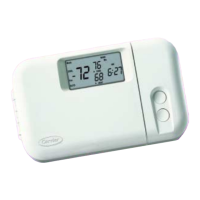
Do you have a question about the Carrier XCT 7 40VCC727FQEE and is the answer not in the manual?
| Brand | Carrier |
|---|---|
| Model | XCT 7 40VCC727FQEE |
| Category | Thermostat |
| Language | English |
Lists key functions like monitoring status, modes, and settings.
Dividing equipment into building, floor, and zone levels for management.
Controlling ON/OFF, mode, wind speed, temperature, etc. for indoor units.
Checking room temperature, coil temperature, air quality, etc.
Setting LIFO, CENTRAL, LOCK modes for VRF and Supermatch units.
Configuring fire signals for automatic equipment shutdown.
Setting weekly and exception day schedules for automatic operation.
Managing multiple accounts and roles for device access.
Importing maps and setting up indoor units for monitoring.
Setting temperature limits and operating capacity for energy saving.
Managing alarms, checking failures, and setting automatic notifications.
Setting threshold alarms for parameters with various notification options.
Setting linkage for AHU/HRV and indoor units for automatic switching.
Setting daylight saving time and automatically adjusting schedules.
Allowing non-admin users to set one-time timing tasks for units.
Accessing and controlling third-party devices via Carrier gateway.
Configuring network settings for local network, WiFi, and LAN access.
Recording device and user operations for system management.
Backing up and restoring system configurations using USB flash disks.
Ancillary settings like temperature unit, region, and language.
Controls power on/off functionality; press for 3 seconds to turn off.
The area for display and user interaction.
Controls screen light; press to turn off/on.
Indicates power status; turns on after powering.
Used to reboot the centralized controller.
Ports for inserting U disks to import/export data.
Connects to a loudspeaker device.
Connection point for grounding.
Function terminals for gateway communication.
Gigabit network port with double access.
Connection for the power adapter.
Gateway address setting for VRF models (1-32).
Gateway address setting for "40VCAR17FQEE" (1-128).
Reserved port.
Connection for fire alarm input.
ModBUS-RTU centralized control data interface.
Connection to third-party gateway (1-128).
Gateway address setting for VRF models (1-32).
MAX-32 capacity for outdoor bus connection.
MAX-32 capacity for outdoor bus connection.
Reserved port.
Connection points for COM3.
Connection points for COM2.
Connection points for COM5.
Connection points for COM4.
Connection points for COM1.
Connection points for COM7.
Explains address assignment for VRF units.
Specifies the available range for gateway addresses.
MAX-128 capacity for COM3 connection.
Diagram showing connections for centralized control.
Explains how to set addresses for single split/multi-type units.
Specifies the limit for concurrent web user logins.
Describes the initial setup process, including language selection.
Configuring network parameters like IP, DNS, and WLAN.
Interface for setting the current date and time.
Setting the initial administrator password.
Accessing the system via username and password.
Main interface for monitoring system status and accessing control functions.
Visual display of devices using icons.
Explains numbered icons and status indicators on the monitoring screen.
Details shown for air conditioner, HRV, and FAU icons.
Switching between icon, list, and floor navigation modes.
Filtering display by device type (all, AC, HRV, fresh air).
Monitoring interface in list mode for ACUs.
Monitoring interface in list mode for HRVs.
Monitoring interface in list mode for Fresh Air units.
Interface for navigating and monitoring equipment on floor plans.
Shows basic states like power on/off, fault, offline.
Controls all devices in a partition.
Importing and displaying floor maps for unit placement.
Controls all equipment in a building or floor.
Viewing partition details like device counts and status.
Controls all equipment in a building or floor.
Viewing partition details in a list format.
Accessing detailed settings for timer mode.
Quick switching of timing tasks via a switch button.
Checking fault details when faults are present.
Similar to IDU monitoring, but with different details for HRVs.
Monitoring interface similar to indoor units for fresh air units.
Interface for setting and sending control parameters for air conditioning.
Controls swing function and activates electric heating.
Functionality to activate electric heating.
Shows controlled IDUs and allows changing internal machine control.
Interface for setting HRV mode, fan speed, and sending commands.
Interface for setting the control state of new fans.
Interface for navigating and monitoring equipment on floor plans.
Used to search for third-party devices by keywords.
Displays current group and allows changing it for control.
Pop-down bar for setting ALL/LIGHT/FAN.
Controls all devices with ON/OFF settings.
Displays light status and allows ON/OFF control.
Shows operation status and allows ON/OFF control.
Displays current equipment faults with details like error code and location.
Displays detailed fault information such as device name, code, and description.
Options to switch between fault types for querying.
Selecting start and end times for history fault queries.
Updates historical fault data after re-selecting times.
Exports alarm data to storage.
Options to switch between alarm types for querying.
Selecting gateways to view alarms, including filtering by bus address.
Updates current alerts after query.
Viewing detailed fault/alarm information like parameters and partition.
Options to switch between alarm types for querying.
Selecting start and end times for history pre-alarm queries.
Displays fault/alarm details like device name, code, and partition.
Searching for and adding air conditioning equipment automatically.
Updating bus and grouping indoor units by gateway.
Filtering units by All/edited/unedited status for commissioning.
Adding or deleting indoor units from the interface.
Manually adding indoor units with parameter modification.
Initiating the automatic online process for devices.
Editing device parameters after generation and saving.
Manually adding indoor units with parameter modification.
Initiating the automatic online process for devices.
Editing device parameters after generation and saving.
Filtering fresh air duct units by All/edited/unedited status.
Adding or deleting corresponding indoor units.
Manually adding indoor units with parameter modification.
Initiating the automatic online process for devices.
Editing device parameters after generation and saving.
Arranging buildings, floors, and zones for partition management.
Selecting, folding, expanding, or editing building names.
Buttons for adding, editing, or deleting buildings.
Viewing floor details and zones.
Buttons for editing floor names or deleting floors.
Displaying the currently selected floor name.
Interface for adding/removing zones and editing devices within zones.
Displaying zone name and devices, with add/delete options.
Setting floor navigation maps and indoor unit positions.
Switching third-party device grouping.
Buttons for editing group names or deleting groups.
Interface for adding/deleting groups and editing names.
Displaying group names and devices, with add/delete options.
Setting threshold and fault prompt conditions for alarms.
Setting how the system prompts for faults or alarms.
Managing external machines, displaying gateway info, and editing names.
Shows the current gateway version.
Setting system mode (single cold/hot, unlimited) and load rate limit.
Setting the upper limit for system operating load.
Button to execute or release parameter changes.
Switching to view external machine running parameters.
Checking and updating current system operation parameters.
Setting weekly timed tasks for automatic execution.
Viewing, enabling, or disabling timed tasks.
Editing the name of a timed task.
Filtering timed actions by equipment type.
Sorting tasks by name or time.
Adding or deleting timed tasks.
Setting cyclic timing tasks for device on/off.
Setting schedules for working days and weekends.
Setting weekly schedules from Monday to Sunday.
Editing existing timer actions.
Setting timed actions for air conditioners.
Viewing or switching control instructions issued by the timing device.
Checking and editing timed actions.
Cancels current new/edit timer actions.
Saves current settings.
Setting timed actions for HRV units.
Setting timed actions for new fresh air units.
Setting special day schedules, like holidays, for automatic execution.
Reviewing timed tasks and their enabled/disabled status.
Setting names for timed actions, with no repetition allowed.
Filtering timed actions by equipment type.
Selecting dates from a calendar for applying exception schedules.
Sorting timed actions by time or name.
Adding or deleting timed tasks from the list.
Switching the enabled/disabled state of timer actions.
Viewing and editing current timer actions.
Switching the availability state of timing functions.
Applying special day settings to specific dates.
Viewing and switching timing programs.
Editing the name of a timing program.
Filtering timed actions by equipment type.
Sorting timing programs by name or time.
Adding or deleting timing programs.
Switching the enabled/disabled state of timer actions.
Viewing and editing current timer actions.
Viewing linkage settings for devices like fans and heat exchangers.
Setting linkage parameters for device startup and shutdown.
Setting fire alarm 01 to normally on, off, or disabled.
Setting fire alarm 02 to normally on, off, or disabled.
Selecting and switching between managed accounts.
Displays the name of the currently selected account.
Saves current account settings.
Setting user names and passwords for accounts.
Setting account validity as permanent or time-limited.
Setting account roles via a drop-down menu.
Binding mailbox and phone numbers to accounts.
Configuring alarm pop-up prompts.
Viewing and setting role names and permissions.
Changing the name of an existing role.
Saves current role permission configurations.
Distinguishing roles based on data access authority.
Setting control authority for devices (open/close).
Selecting/canceling function permissions for roles.
Interface for deleting roles and their associated permissions.
Switching display language for the host and web interface.
Selecting LAN1, LAN2, or WLAN for network connection.
Setting IP address acquisition mode (automatic or static).
Configuring DNS access mode (automatic or manual).
Interface for adjusting year, month, day, hour, minute, and second.
Adjusting the brightness of the display.
Adjusting the sound volume.
Toggling the daylight saving time feature on or off.
Setting the start and end times for daylight saving.
Adjusting the time for daylight saving compensation.
Cancels current changes and exits the interface.
Saves current changes and exits the interface.
Switching between Celsius and Fahrenheit units.
Icon to edit energy-saving limits and indoor unit quantities.
Adding/deleting energy-saving settings or marking them as invalid.
Switching energy saving settings to enable/disable state.
Configuring Modbus settings for third-party interfaces.
Process for updating software version using a U disk.
Steps for exporting configuration data to a USB drive.
Steps for restoring exported data from a USB drive.
Process for performing a factory data reset.
Settings for remote access via webserver, including IP and port.
Accessing the webserver via a specified URL.
